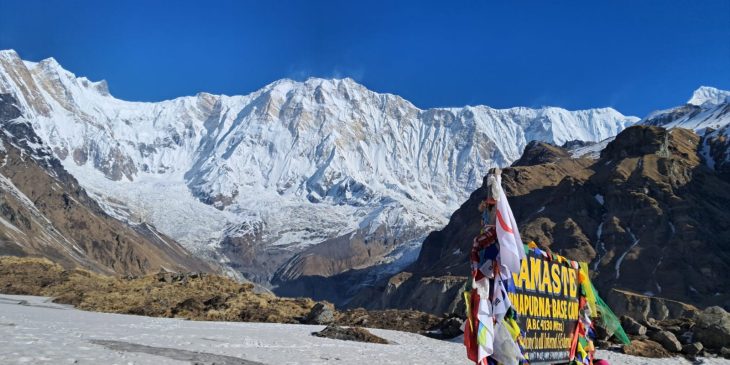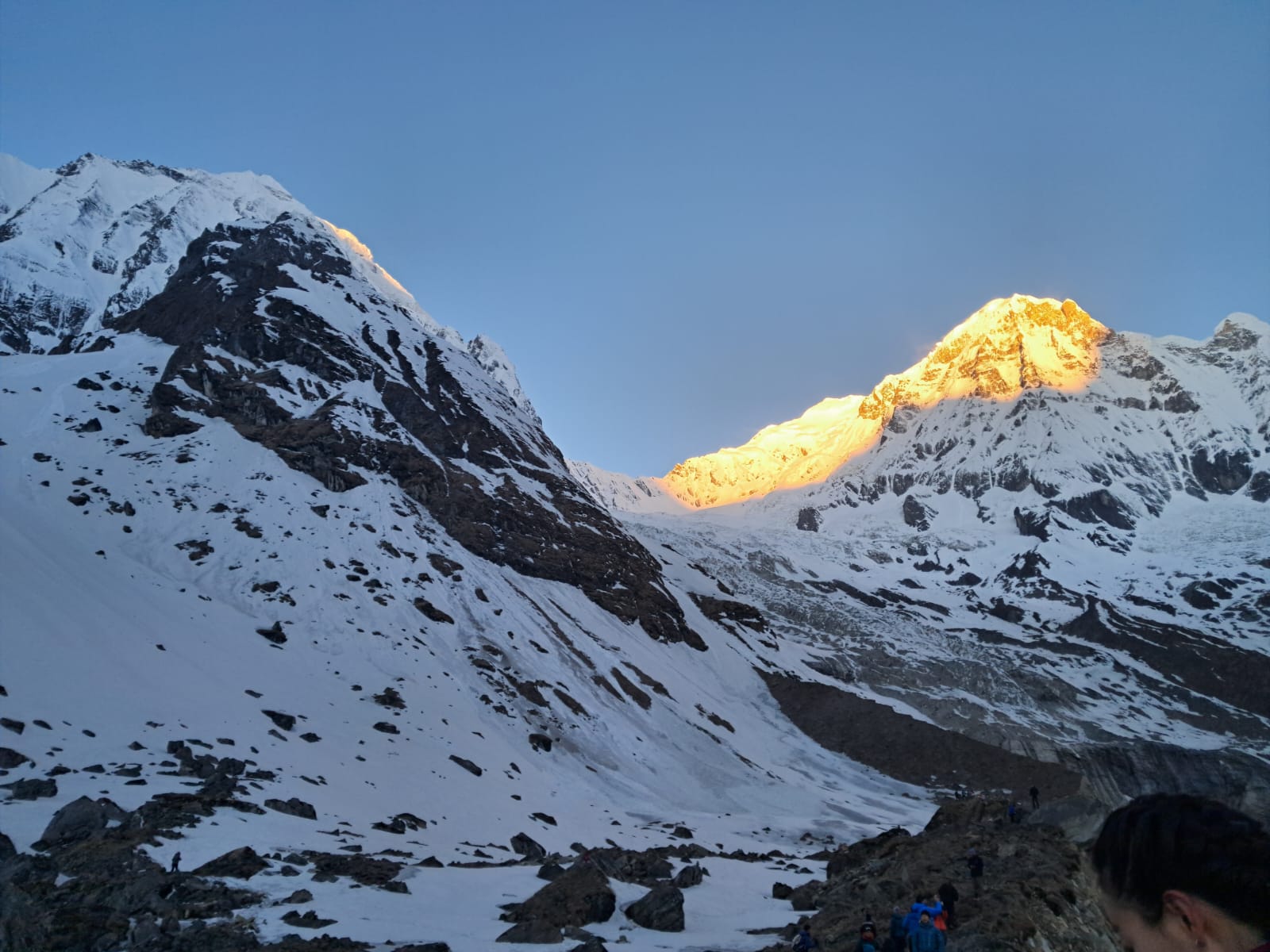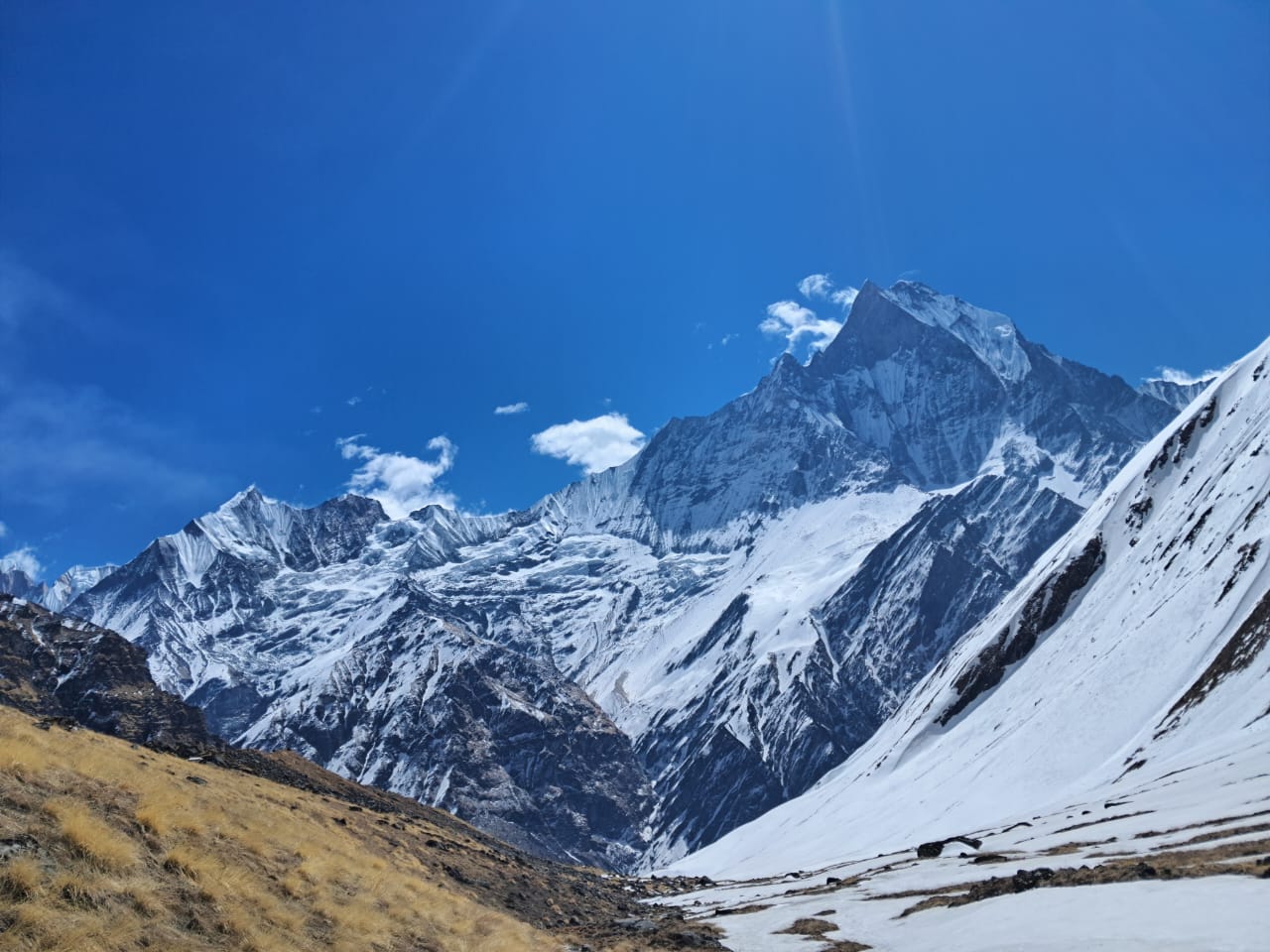
Annapurna Base Camp stands as a pinnacle of trekking adventures, beckoning adventurers from around the world to explore its majestic beauty. This journey not only offers unparalleled mountain views, a trek through enchanting bamboo forests, and the opportunity to immerse oneself in the tranquility of Himalayan nature but also poses a respectable challenge that requires thorough preparation and acclimatization to avoid altitude sickness. How to prepare for Annapurna Base Camp Trek is the experience of watching the sunset over the Annapurna range, coupled with the unique culture of the mountain teahouses and the warmth of Nepali hospitality, makes the Annapurna Base Camp trek a bucket-list adventure for many.
In this article, we will guide you through the essential steps to prepare for your Annapurna Base Camp Trek, including an overview of the trek, detailed preparation tips, navigating routes, and what to expect in terms of cost. Further, we delve into life on the trail, covering crucial aspects such as food, water, accommodation, and how to tackle challenges like altitude sickness through proper acclimatization. By understanding the logistics of getting to and from the ABC trek and what to pack, you’ll be well on your way to an unforgettable journey through some of the most stunning landscapes that the Annapurna region of Nepal has to offer.

Table of Contents
Annapurna Base Camp Trek Overview
Distance and Duration
The Annapurna Base Camp Trek spans approximately 115 kilometers, with trekkers walking an average of 10 to 20 kilometers per day. The trek typically lasts between 11 and 14 days, although shorter versions are available that can be completed in about 8 to 9 days.
Total Ascent and Descent
Throughout the trek, participants will experience a total elevation gain of roughly 5,255 meters and an elevation loss of 5,405 meters. This variance is due to the undulating nature of the trail which includes numerous ascents and descents.
Highest Point and Difficulty Level
The highest point of the Annapurna Base Camp Trek is at 4,130 meters. The trek is classified as moderate in terms of difficulty. Trekkers will navigate steep and rugged trails, including extensive stone stairs, which require continuous walking for 5 to 6 hours per day.
Permits and Costs
To embark on this trek, two essential permits are required: The Annapurna Conservation Area Permit (ACAP) and the Trekking Information Management System (TIMS) Permit. The ACAP costs approximately NPR 3,000 ($25 USD) per person, while the TIMS Permit costs $20 USD for individual trekkers and $15 USD if applied through a registered agency. These permits are mandatory and checked at various checkpoints along the trek.
Accommodation Options
Accommodation along the Annapurna Base Camp Trek varies greatly, ranging from teahouses and lodges to camping options. Teahouses are the most common, providing basic amenities such as beds, blankets, and meals. As trekkers ascend, the availability of accommodations with attached bathrooms’ decreases, and the style becomes more basic. In higher elevations, accommodations are typically shared, with limited private room options available.
How To Prepare For The Annapurna Base Camp Trek
Physical Preparation
Preparing for the Annapurna Base Camp Trek requires a combination of cardiovascular, strength, and endurance training. Engage in long-distance running, swimming, or other endurance activities to build stamina. Incorporate aerobic exercises and strength training routines such as lunges, squats, and stair running to enhance your physical resilience. Regular hiking, especially on hills and uneven terrains, is crucial as it simulates the conditions you’ll face on the trek. It’s advisable to start training at least three to five months in advance, gradually increasing the intensity and duration of your workouts to build your endurance and strength.
Mental Preparation
Mental toughness plays a critical role in successfully completing high-altitude treks. Practice visualization techniques by imagining yourself conquering the trek and standing atop the summit. This mental exercise enhances your psychological resilience and prepares you for the challenges ahead. It’s also essential to maintain a positive mindset and focus on your reasons for undertaking the trek, whether for personal achievement, exploration, or self-discovery. Mindful meditation can be a valuable tool during training, helping you stay present and focused.
Essential Gear Checklist and Preparation
Packing the right gear is vital for your comfort and success on the Annapurna Base Camp Trek. Your gear list should include:
- Clothing: Waterproof and windproof jackets, lightweight trekking pants, moisture-wicking undergarments, and thermal layers for colder altitudes.
- Footwear: Well-broken-in water-resistant hiking boots with ankle support are essential to prevent blisters and provide stability.
- Backpacks and Bags: A sturdy backpack with a waist strap to distribute weight evenly is crucial. Your pack should be capable of carrying all your essentials without being too cumbersome.
- Sleeping Gear: Depending on the season, a four-season sleeping bag and an insulating sleep sheet are recommended for warmth during cold nights.
- Toiletries and First Aid: Include items like biodegradable wipes, hand sanitizer, sunscreen, lip balm, and a comprehensive medical kit to address common ailments and injuries.
- Navigation and Tools: A waterproof map, compass, and a reliable head torch are necessary for navigating the trails safely.
- Hydration and Nutrition: Water purification tablets and a durable water bottle or hydration bladder are essential. Also, pack high-energy snacks to maintain your energy levels throughout the trek.
By adhering to these guidelines and ensuring you have the appropriate training, mindset, and equipment, you’ll be well-prepared to tackle the Annapurna Base Camp Trek and enjoy the breathtaking beauty of the Himalayas.
Starting Points and Itinerary Options
The Annapurna Base Camp (ABC) trek offers various starting points and itinerary options, tailored to accommodate different time frames, fitness levels, and trekker preferences. Popular starting points include Nayapul.
Combining ABC with Other Treks
Many adventurers opt to enhance their Himalayan experience by combining the ABC trek with other popular routes. The Poon Hill trek or the Mardi Himal trek are excellent additions that can be integrated into the ABC itinerary. Starting in Nayapul, trekkers can extend their journey to include Ghorepani Poon Hill before proceeding to ABC, typically requiring 8-10 days in total. Alternatively, combining the ABC trek with Mardi Himal begins either from Kande or by taking a jeep to Siding, then trekking through Mardi Himal Base Camp to Landruk before joining the ABC trail, which generally takes about 10-11 days.
Advice on Trekking Independently vs. With a Guide
The decision to trek independently or with a guide depends largely on personal preference, budget, and trekking experience. Trekking independently is often less expensive and offers more flexibility, allowing trekkers to set their own pace and enjoy the solitude of the mountains. However, hiring a guide or a porter can greatly enhance the trekking experience by providing local knowledge, logistical support, and additional safety, especially for solo trekkers or those unfamiliar with high-altitude hiking. Guides can ensure accommodations are pre-booked during peak seasons and assist with navigating more challenging sections of the route. The cost of hiring guides or porters is reasonable by Western standards, typically ranging from $25 to $30 per day.
What To Expect
All-inclusive Trek Packages
When opting for an all-inclusive trek package, trekkers can expect a comprehensive service that covers essential aspects of the journey. These packages typically include permits and entrance fees, accommodation which may vary from camping to lodges, and all meals during the trek. Additionally, the cost covers porter and/or guide services, which are crucial for navigating the trails and managing logistics. Transportation to and from the trailhead is also included, ensuring trekkers have a smooth start and finish to their trekking experience. This information will help you to know about how to prepare for the Annapurna Base Camp trek.
Trekking with Porter and Guide
Hiring a porter and a guide can significantly enhance the trekking experience by providing support and local insights. Porters carry the main luggage, allowing trekkers to walk with just a lightweight daypack, which is especially beneficial at higher elevations. Guides ensure trekkers stay on the correct route and provide valuable information about the region. The cost for a guide and a porter on the Annapurna Base Camp Trek typically ranges between $30 to $35 per day for a guide and $20 to $25 per day for a porter. This investment not only aids in a smoother trek but also supports the local economy and the livelihood of these professionals.
Trekking Insurance Essentials
Securing the right insurance coverage is crucial for any trekking adventure. Trekkers should ensure their policy includes medical and evacuation insurance to cover potential illnesses or injuries. Additionally, trip cancellation/interruption insurance is advisable to protect the investment in the trek. Gear insurance is also recommended to cover any lost, stolen, or damaged equipment. These insurance considerations are vital for peace of mind and handling unexpected situations during the trek.
Life on the Trail: Food, Water, and Accommodation
Teahouse Culture and Costs
Teahouses are integral to the trekking experience in the Himalayas, serving as communal hubs where trekkers can rest, eat, and interact with other travelers. These establishments offer basic to deluxe accommodations, with prices typically ranging from $10 to $15 per night for a cozy room equipped with essentials like clean bedding and sometimes even facilities for charging electronic devices. Meals at teahouses vary, but a standard fare of three meals can cost between $20 and $30 per person per day, providing hearty local dishes like dal bhat, momos, and thukpa.
Food Choices Along the Route
The culinary offerings along the Annapurna Base Camp Trek are a delightful mix of local and international cuisines, ensuring that trekkers can find both comfort and variety in their meal choices. Breakfast might include items like Tibetan bread and pancakes, while lunch and dinner menus offer staples such as dal bhat, noodles, and even pizza or pasta in some locations. It’s recommended to indulge in local Nepali meals which are not only cost-effective but also provide the necessary nutrients for the strenuous trek.
Hydration Tips and Water Sources
Hydration is crucial in the high-altitude environment of the Annapurna Base Camp Trek. Trekkers are advised to drink between 3-4 liters of water daily to prevent dehydration and altitude sickness. While teahouses provide boiled water, it’s wise to carry a reusable water bottle with a filter straw or use chlorine or iodine tablets to treat water from local sources. This ensures access to safe drinking water throughout the trek and helps maintain hydration levels without relying solely on purchased water.
Getting To And From the Annapurna Base Camp Trek
Arriving in Pokhara
Pokhara serves as the gateway for the Annapurna Base Camp Trek. Travelers can reach this picturesque city from Kathmandu by air in about 30 minutes, offering a swift and scenic option compared to the road journey. For those preferring the road, tourist buses provide a budget-friendly and immersive travel experience, taking approximately 6 to 8 hours from Kathmandu. Once in Pokhara, adventurers can enjoy the tranquil lakeside setting and prepare for their trek.
Transportation to the Trailhead
The journey to the starting point of the trek, Nayapul, is typically a 2-hour drive from Pokhara. Local buses and taxis are readily available, making it easy to arrange transport to this critical juncture. Before embarking on the trail, trekkers must secure their TIMS and ACAP permits, which are essential for accessing the trekking routes within the Annapurna Conservation Area. The road to Nayapul offers a mix of scenic views and rugged terrain, setting the stage for the adventure ahead.
Returning to Civilization
After completing the trek, many choose to return to Pokhara via different routes depending on their exit point from the trail. For instance, a Jeep ride from Jhinu to Pokhara provides a thrilling and picturesque descent, taking about 4 hours. This route allows trekkers to gradually transition from the remote trails back to urbanity, soaking in the last views of the Annapurna landscape before re-entering the bustling city life.
Each transportation option, whether arriving in Pokhara or departing from the trek, plays a crucial role in the overall experience of the Annapurna Base Camp adventure, ensuring safety, convenience, and a deep connection with the stunning natural environment of Nepal.

Frequently Asked Questions
1. What are the recommended preparations for the Annapurna Base Camp trek?
To adequately prepare for the Annapurna Base Camp trek, it’s advised to engage in multi-day training or hiking well in advance. As the trek approaches, increasing the frequency and intensity of your training is beneficial. Expect to walk several hours at a time while carrying about 3 liters of water and wearing a down jacket or fleece, depending on the weather conditions.
2. Is the Annapurna Base Camp trek suitable for beginners?
Yes, the Annapurna Base Camp trek is an excellent choice for beginners who are looking for an adventurous yet manageable trekking experience. The journey typically starts from Pokhara, leading to Nayapul and then to Ulleri. From there, trekkers pass through picturesque villages, terraced fields, and lush rhododendron forests, making the experience both scenic and rewarding.
3. What level of fitness is required for the Annapurna Base Camp trek?
A good level of physical fitness is necessary for the Annapurna Base Camp trek. Trekkers usually cover 10 to 12 kilometers (approximately 6 to 7.5 miles) per day. To prepare, it is advisable to practice hill walking in your local area, which will help condition your body for the daily trekking demands in Nepal.
4. How challenging is the Annapurna Base Camp trek?
The Annapurna Base Camp trek is moderately challenging. Although the trail generally ascends gradually, it includes several steep ascents and descents. Proper preparation is essential to successfully navigate these parts and enjoy the trekking experience.




















